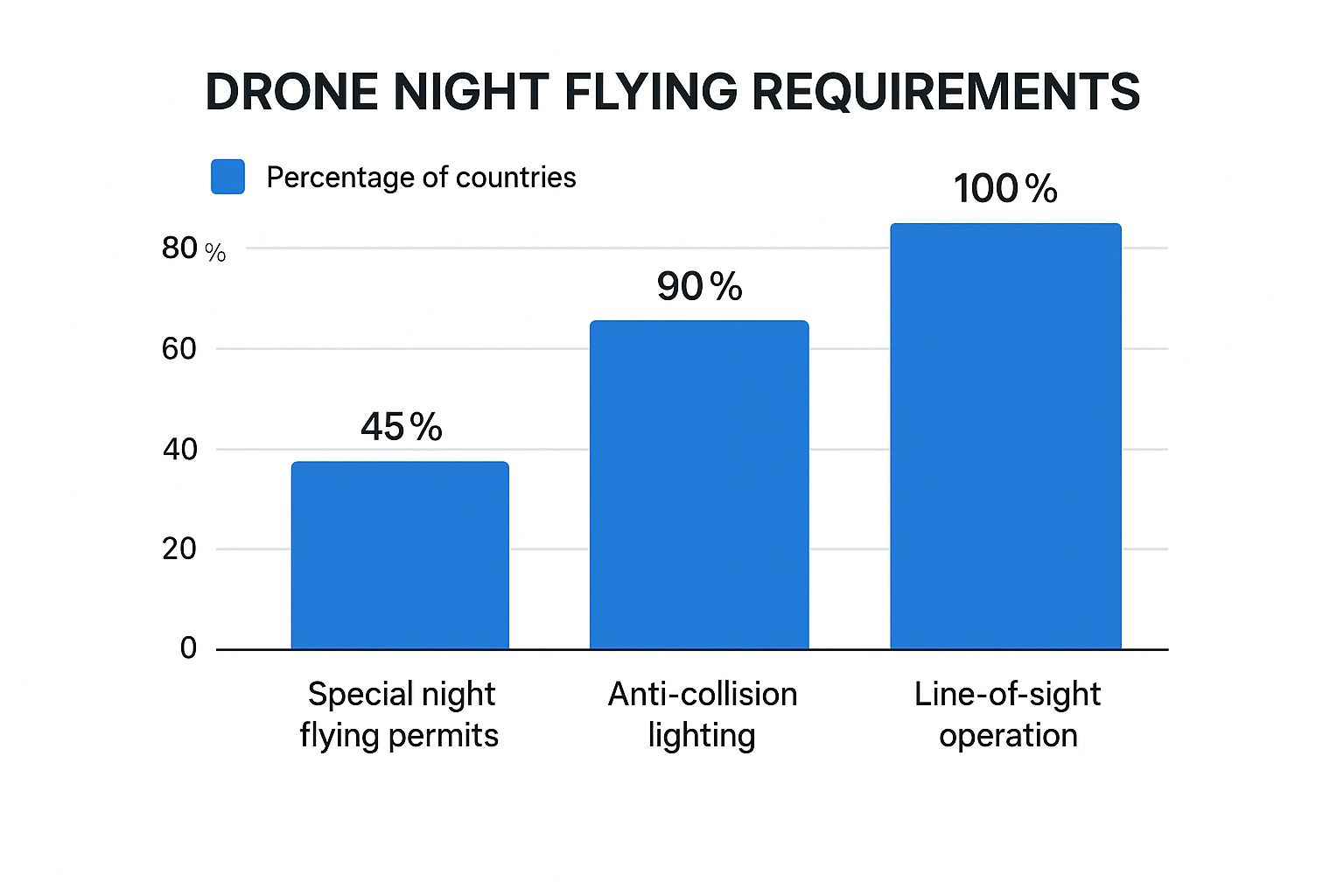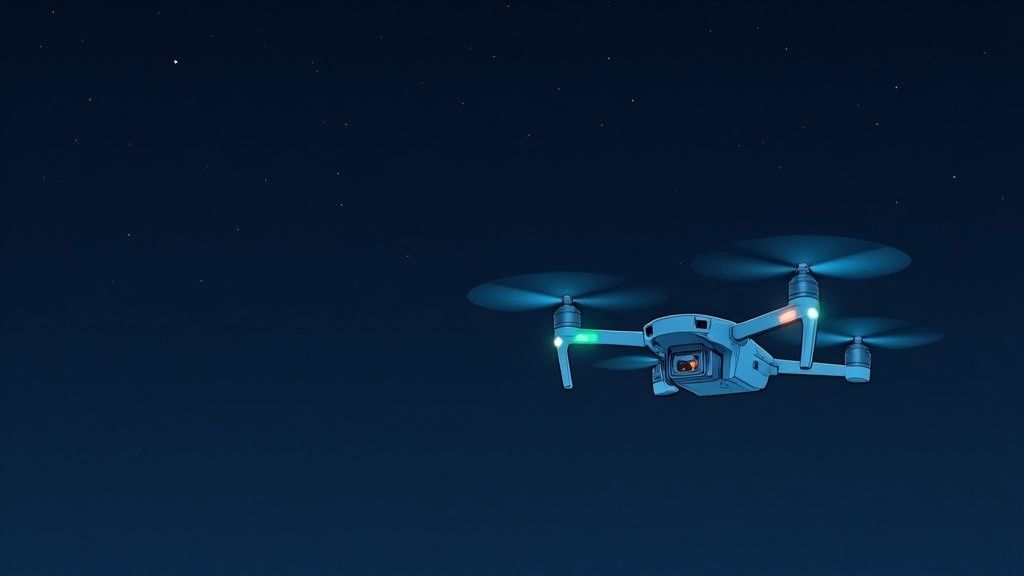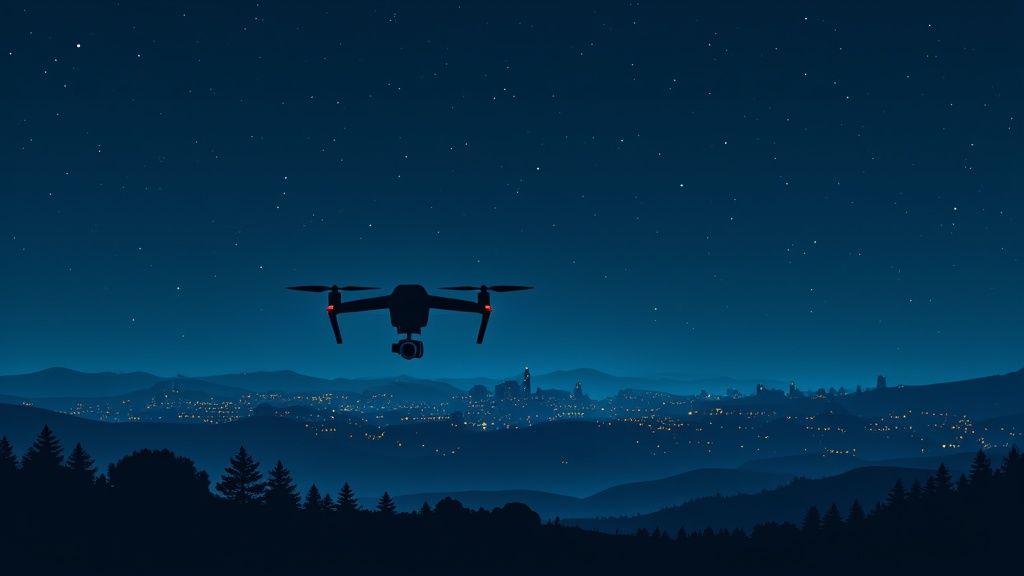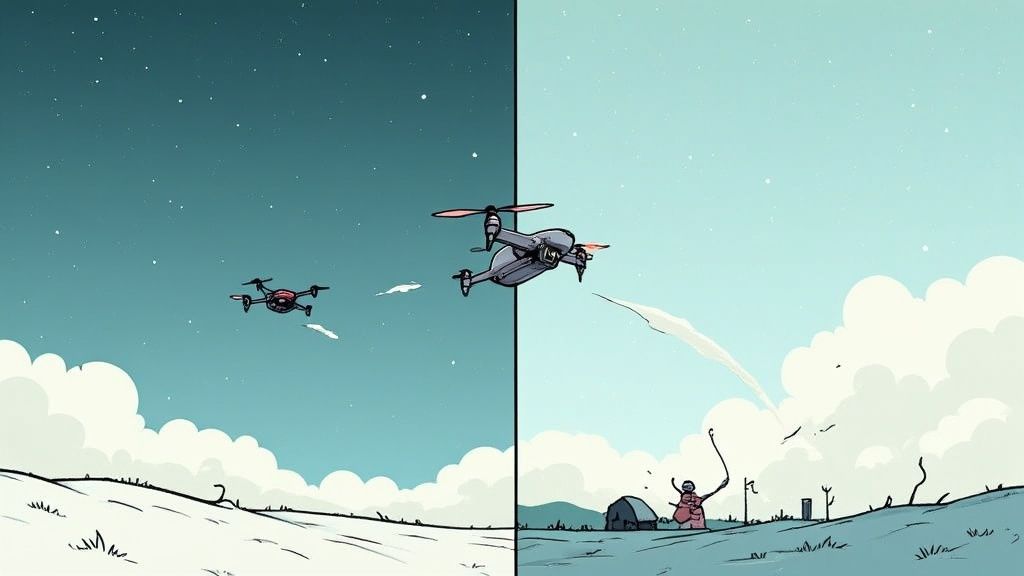Can You Fly a Drone at Night? Everything You Need to Know
- Paul Simmons

- Jun 18
- 13 min read
Breaking Down Modern Night Flying Regulations
For years, flying a drone after sunset felt like a special privilege, reserved for professionals who navigated a complex approval process. The old rules treated night operations as an exception, requiring a slow waiver system that often held back new uses for drone technology. But as drones became more capable and safer, regulators saw that flying at night wasn't just a novelty—it was crucial for emergency services, creative projects, and advanced commercial work. This understanding led to a major change, moving from near-prohibition to a system of managed access that opened the skies to more pilots.
The Shift from Waivers to Training
The old system of granting permission on a case-by-case basis just couldn't keep up. As drone technology got better, the safety arguments for night flights became stronger, making the waiver-by-waiver approach feel outdated. A key moment arrived in the United States when significant regulatory updates took effect in 2021. These new rules now allow both Part 107 commercial pilots and recreational flyers to operate at night without a special waiver.
Instead of paperwork, the focus has shifted to the pilot's knowledge. The new requirement is that pilots must complete updated training that specifically covers the unique challenges and procedures of night operations. This ensures they are ready for the different visual environment and potential risks. You can get more information on these important UAS updates in the U.S. to see how the landscape has changed.
This infographic outlines some of the most common requirements you'll encounter for night flights around the world.

The data shows that while rules are becoming more flexible, core safety principles are nearly universal. Equipping drones with anti-collision lighting and maintaining a visual line of sight are standard mandates everywhere.
To better understand this transition, let's compare the old waiver-based system with the current rules for night flying in the U.S.
This table shows a clear shift in philosophy. The burden has moved from administrative approval (waivers) to pilot responsibility (training), making night flights more accessible while still prioritizing safety through education and proper equipment.
Navigating the Rules Today
This new approach empowers pilots but also puts more responsibility on their shoulders. It's no longer about getting a one-time permission slip; it's about proving you have the ongoing knowledge to fly safely whenever you operate. Official resources are your most valuable tool for staying current. The FAA's main portal for drone operators is a key starting point.

This official hub gives you direct access to safety guidelines, registration portals, and testing information—all essential for any pilot planning to fly at night. While the U.S. has made its process more direct, it's critical to remember that rules can differ a lot from one country to another. For a wider view, you might find our guide on understanding drone regulations helpful for international operations.
Essential Gear That Makes Night Flying Possible
Thinking you can just launch your drone after dark and get amazing results is a common mistake. Answering the question "can you fly a drone at night" successfully moves beyond legal permission and into the world of specialized equipment. Success in night operations depends on having the right gear that turns your drone from a daytime device into a capable, safe, and professional low-light platform. It’s not about makeshift solutions; it’s about using equipment designed for the unique challenges of darkness.
Anti-Collision Lighting: More Than Just a Light
The most critical piece of equipment is your anti-collision lighting. This isn't just about ticking a regulatory box; it's the single most important safety feature for making your drone visible to other aircraft and observers on the ground. Think of it as the drone's equivalent of a lighthouse beacon, cutting through the darkness to prevent collisions.
A crucial safety requirement mandates that drones be equipped with anti-collision lighting visible from at least 3 statute miles. These lights must have a flash rate sufficient to provide collision avoidance and be mounted on top of the aircraft to be visible from above. This top-mounted position is vital for safety, ensuring manned aircraft flying overhead can spot your drone. You can review the full details of these crucial UAS rule changes in the U.S. to understand their importance.
When choosing your lighting, pay attention to these key factors:
Visibility Range: Does it meet or exceed the 3-mile requirement? Don't settle for less.
Mounting Position: Is it designed for top-mounting to ensure visibility to other aircraft?
Power Source: Does it have a self-contained battery? This prevents draining your drone’s main power source, which could shorten your flight time unexpectedly.

Major drone manufacturers and third-party companies offer a variety of accessories specifically for night operations. This assortment of official gear highlights how integral components like intelligent flight batteries, charging hubs, and specialized camera filters are to extending a drone's capabilities after sunset.
To help you navigate the options, here is a comparison of common anti-collision lights.
Anti-Collision Light Specifications and Options
Technical requirements and popular lighting solutions for night drone operations
This table shows that while basic strobes meet the minimum requirements, investing in a multi-color or high-intensity option can significantly increase your drone's visibility, adding an extra layer of safety.
Beyond the Basics: Advanced Night Equipment
For professional applications, the right gear goes well beyond just lighting. Cold night air can significantly reduce battery performance, so having extra, fully charged batteries is non-negotiable. Many pilots find their flight times are 15-25% shorter in colder, darker conditions.
Furthermore, advanced sensors are what separate professional night flying from amateur attempts. Thermal cameras are a perfect example, allowing operators to "see" heat signatures in total darkness. This is invaluable for:
Search and Rescue: Locating missing persons by their body heat.
Security Surveillance: Detecting intruders who are invisible to standard cameras.
Infrastructure Inspection: Identifying heat-related faults in electrical systems or solar panels.
Finally, an enhanced GPS system is vital. When the ground below is a sea of darkness, your visual references disappear. A robust GPS lock becomes your primary tool for knowing your drone's precise location, ensuring you can operate with confidence and bring it home safely every time.
Navigating International Night Flying Rules
While the United States has made it more straightforward to fly a drone at night, the moment you cross an international border, you enter a completely different world of regulations. Planning to travel with your drone requires more than just packing an adapter; it demands careful research into local aviation laws, which can vary dramatically from one country to the next. What's considered a routine operation in one nation could be heavily restricted or even illegal in another.
These differences aren't random. They often reflect a country's unique approach to managing its airspace, population density, and public safety priorities. For example, some nations that welcome drone tourism during the day adopt a much stricter posture after sunset. Enforcement can also differ significantly between a quiet rural area and a bustling city center, making local knowledge essential.
Global Differences in Night Drone Operations
Around the world, regulations for flying drones at night are anything but standard, reflecting the diverse safety priorities of national aviation authorities. While the FAA in the U.S. now permits night flights with proper training and anti-collision lights, many countries maintain tighter controls. In Canada, for instance, operators must obtain a special, advanced license to fly drones after dark, which means they must demonstrate a higher level of knowledge and risk management. You can explore more about these international regulatory differences to better prepare for any travels.
A great starting point for any international pilot is to check resources from major aviation bodies that aim to standardize drone rules. The International Civil Aviation Organization (ICAO), for example, provides tools to help pilots understand global frameworks.
This toolkit from ICAO offers a central place to grasp the foundational principles that many national authorities use to build their specific regulations. It highlights a worldwide effort toward harmonizing drone rules, even though we're not quite there yet.
Key International Regulations at a Glance
So, how do the rules stack up in other popular destinations? The answer to "can you fly a drone at night" changes depending on your location. Here’s a quick look at what you might encounter:
This comparison shows there's no one-size-fits-all answer for international night flying. Always check the official aviation authority website for your destination country long before you pack your drone.
Confronting the Real Dangers of Night Operations
Answering the question "can you fly a drone at night?" goes far beyond just rules and gear. It requires a serious look at how darkness completely changes the game of flight. Flying after sunset isn't just daytime flying with some lights strapped on. The biggest hurdles are often mental, catching even experienced pilots by surprise when the visual cues they depend on disappear.
Your brain heavily relies on landmarks and the horizon to judge distance and orientation, and it's easily tricked in the dark. This change in perception creates new risks, turning a routine flight into a dangerous situation when your main safety tool—your own vision—is limited. This is why a strong foundation in general [drone safety tips](https://www.jabdrone.com/post/drone-safety-tips-how-to-avoid-accidents-and-hazards) is non-negotiable before you even think about flying at night. Without that solid safety mindset, the unique pressures of night operations can quickly lead to bad decisions.
The Psychology of Darkness
When the sun goes down, your spatial awareness shrinks dramatically. Imagine trying to walk through your living room with all the lights off. You know the layout, but you'll move cautiously, probably bumping into furniture you'd effortlessly sidestep during the day. This same sense of disorientation can happen to a drone pilot.
For instance, several things become much harder:
Judging distance is almost impossible. A single point of light could be a nearby porch light or a cell tower miles away.
Sensing altitude and speed is a struggle without a clear horizon line or familiar ground references to guide you.
Sudden weather changes, like fog rolling in or an unexpected rain shower, are far more dangerous when you can't see them coming.
Aviation incident reports frequently point to disorientation as a major cause of accidents. The National Transportation Safety Board (NTSB), for example, analyzes accident data to help prevent future incidents, and their findings are a stark reminder of these risks. These reports consistently show that losing situational awareness is a key factor in aviation incidents, a danger that multiplies significantly during night operations.
Maintaining Situational Awareness
To combat these dangers, pilots need to build new habits. It takes the human eye up to 30 minutes to fully adjust to the dark, a process known as dark adaptation. A quick glance at a bright smartphone screen can completely reset this adaptation, instantly wiping out your ability to see your drone or spot potential obstacles.
Successful night flying means shifting your trust from your eyes to your instruments. You must learn to treat your drone’s telemetry data—altitude, speed, distance, and heading—as your ultimate source of truth. By creating a decision-making process that anticipates these darkness-specific challenges, you can fly safely and with confidence long after the sun has set.
Unlocking Night Flying's Commercial Potential
Once you have the right equipment and a solid grasp of the rules, the question of "can you fly a drone at night" transforms into a key that unlocks a whole new set of professional opportunities. These aren't just ideas on a whiteboard; they are real, growing markets where pilots certified for night operations have a significant advantage. The ability to fly after sunset is changing entire industries by providing data and viewpoints that were once either impossible or far too expensive to get.
Think about a security company hired to watch over a large industrial park. During the day, fences and standard cameras might be enough. But at night, when the site is most vulnerable, a drone equipped with a thermal camera becomes a game-changer. It can patrol a huge perimeter efficiently, spotting intruders by their heat signatures long before they get close to a building. This isn't just about catching someone in the act; it's about providing cost-effective, proactive security when the risks are at their peak.
High-Value Applications After Dark
The business case for flying drones at night goes well beyond basic security patrols. Various sectors are finding unique ways to benefit from after-dark operations:
Infrastructure Inspection: Utility companies can use thermal drones to check on power lines or substations. Components that are overheating—a clear sign of a potential failure—glow brightly against the cool night air, making them easy to spot. This same problem is often completely hidden during the day.
Cinematography: The night provides dramatic, moody lighting that can make a film or commercial stand out. Skilled drone pilots can capture breathtaking cityscapes, dynamic car chases, or atmospheric establishing shots that fetch premium rates.
Search and Rescue (SAR): For SAR teams, a thermal drone can be a life-saving instrument. In the crucial hours after someone is reported missing, a drone can scan a vast area and detect a person's body heat in total darkness, drastically cutting down search times.
The chart below from Drone Industry Insights shows the top commercial uses for drones, many of which become even more effective with night flight capabilities.

This data reveals that industries like Energy, Construction, and Agriculture are at the forefront of drone adoption. Night operations give them an extra edge for tasks like thermal inspections and monitoring project progress. Getting your commercial license is the first step, and if you're interested in the details, you can learn more about [why you need a 107 license to fly a drone commercially](https://www.jabdrone.com/post/why-you-need-a-107-license-to-fly-a-drone-commercially) in our guide. Remember, these specialized night missions also come with greater responsibilities, requiring advanced pilot skills and sometimes higher insurance premiums to cover the unique operations.
Building Night Flying Skills That Actually Work
Reading about night flying is one thing, but developing the confidence and competence to do it safely is another challenge entirely. Answering the question “can you fly a drone at night” moves beyond regulations and into practical ability. Real-world skills are built through a step-by-step training approach, not by simply checking off regulatory boxes. This journey often starts not in the sky, but on a computer screen.
The Crucial Role of Simulators
Before you even consider your first flight after sunset, think about the value of simulator training. A flight simulator is like a no-risk digital playground where you can crash and learn without any real-world consequences. It’s the perfect place to practice emergency scenarios—like losing your GPS signal or experiencing a sudden control issue—that would be terrifying and dangerous in actual darkness.
Simulators are exceptional for building muscle memory and learning to trust your instruments over your eyes, a core skill for night operations.
From Theory to Practice
Once you feel comfortable in the simulator, the next step is to build real-world experience gradually. Don’t make your first night flight a complex mission. Instead, focus on mastering the basics. For pilots just starting out, our foundational guide on [how to fly a drone for beginners](https://www.jabdrone.com/post/how-to-fly-a-drone-for-beginners-get-started-today) can provide a solid baseline before you tackle more advanced conditions.
Start with simple, proven exercises to build your confidence and improve your spatial awareness in the dark:
Hovering and Orientation: Practice holding a steady hover at different altitudes and rotating the drone. This helps you get a feel for how the anti-collision lights behave as the drone turns.
Basic Maneuvers: Fly simple box patterns and figure-eights. Concentrate on making smooth, deliberate control inputs.
Controlled Landings: Practice landing in a designated, well-lit area. This is much harder at night when your depth perception is compromised.
The FAA provides resources for commercial operators which often contain safety best practices that are useful for all pilots.

This portal for commercial operators highlights the FAA’s focus on structured training and operational knowledge, which is the bedrock of safe night flying. True competency comes from systematic practice, gradually increasing the complexity of your flights as you become more comfortable. This methodical approach ensures you develop the sharp decision-making skills needed when darkness limits your visual cues, turning a daunting challenge into a manageable skill.
Your First Night Flight: A Realistic Action Plan
Moving from daytime flying to your first night mission is a major milestone. To make sure it’s a positive memory, you need a solid action plan. Answering "can you fly a drone at night" safely has less to do with your skill mid-flight and more to do with careful preparation. The golden rule is to scout your location in broad daylight. A spot that looks ideal during the day can easily hide hazards like power lines, thin tree branches, or uneven ground that completely disappear after sunset.
Think of your daytime scouting trip as a formal safety inspection. Identify any potential dangers and map out your flight path to avoid them. This is also the perfect opportunity to assess the surrounding airspace. Using tools like aviation charts will give you critical information about potential air traffic and any restricted zones.
Here is a sectional chart from SkyVector, which pilots use to understand airspace classifications and potential hazards.
This chart reveals a complex web of flight paths, restricted airspaces, and ground-level obstacles like towers. It's a clear illustration of why a detailed pre-flight check is not something you can afford to skip.
Building Your Pre-Flight Checklist
For your first few night flights, keeping it simple is your best strategy. The objective isn't to capture cinematic masterpieces but to build confidence and get a feel for how the drone behaves in the dark. You’ll want to create a night-specific checklist that goes beyond your usual daytime routine.
Equipment Check: First, confirm your anti-collision lights are working correctly and are visible. Make sure all batteries—for the drone, the controller, and your phone or tablet—are charged to 100%. Cold night air can deplete batteries much quicker than you might expect.
Weather Monitoring: Check the forecast right before you head out. Pay special attention to wind speed, the chance of precipitation, and visibility. Fog can appear surprisingly fast at night, leading to a confusing and dangerous situation.
Site Illumination: Prepare a well-lit area for your launch and landing. It’s best to use cone-shaped lighting to prevent glare that could disrupt your vision. It can take the human eye up to 30 minutes to fully adjust to the dark, and one quick look at a bright light can instantly reset your night vision.
Emergency Plan: Have a clear plan for what to do if you lose connection or have a malfunction. Your Return-to-Home (RTH) altitude should be set high enough to clear every obstacle you noted during your daytime scouting.
Executing the Flight
Begin with basic maneuvers. Practice hovering, making slow and steady movements, and performing controlled landings within your lit-up zone. Fight the temptation to fly too far or too high. Your main goal is to become comfortable relying on your drone's telemetry data—like altitude, distance, and speed—instead of your own compromised eyesight.
By taking a methodical and step-by-step approach, you'll build the essential skills and mental readiness that ensure every future night flight is a success.
For pilots ready to explore the skies with confidence, whether by day or night, [JAB Drone](https://www.jabdrone.com) provides expert guides, reviews, and a supportive community to help you master every part of drone operation.




Comments